GMC SIERRA 1994 Owners Manual
Manufacturer: GMC, Model Year: 1994, Model line: SIERRA, Model: GMC SIERRA 1994Pages: 404, PDF Size: 20.91 MB
Page 311 of 404
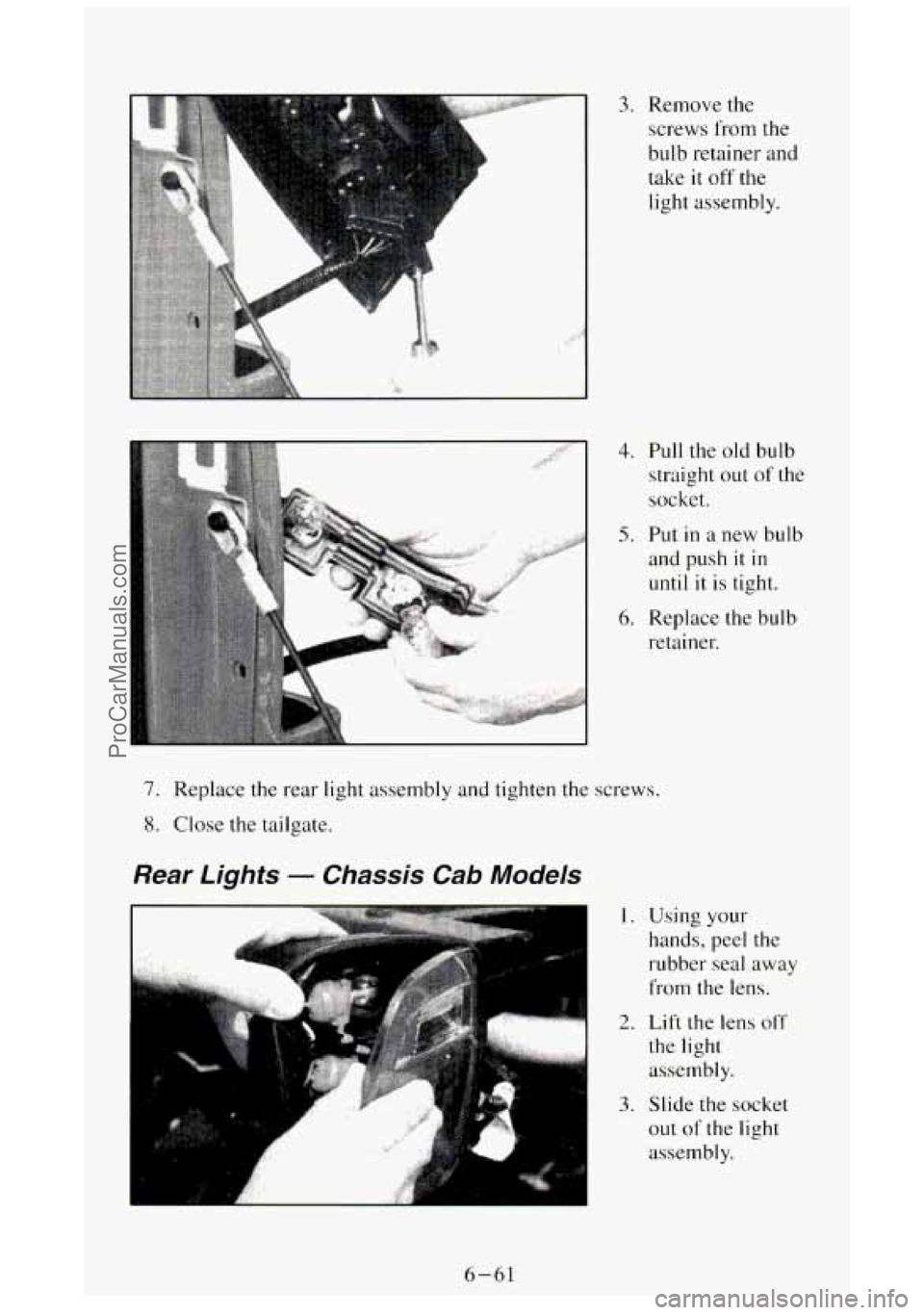
3. Remove the
screws
from the
bulb retainer and
take
it off the
light assembly.
4. Pull the old bulb
straight
out of the
socket.
5. Put in a new bulb
6. Replace the bulb
retainer.
7. Replace the rear light assembly and tighten the screws.
8. Close the tailgate.
Rear Lights - Chassis Cab Models
..
:F
1. Using your
hands. peel the
rubber seal away
from the lens.
2. Lift the lens off I,. . the light
assembly.
3. Slide the socket
out
of the light
assernbly.
6-61
ProCarManuals.com
Page 312 of 404
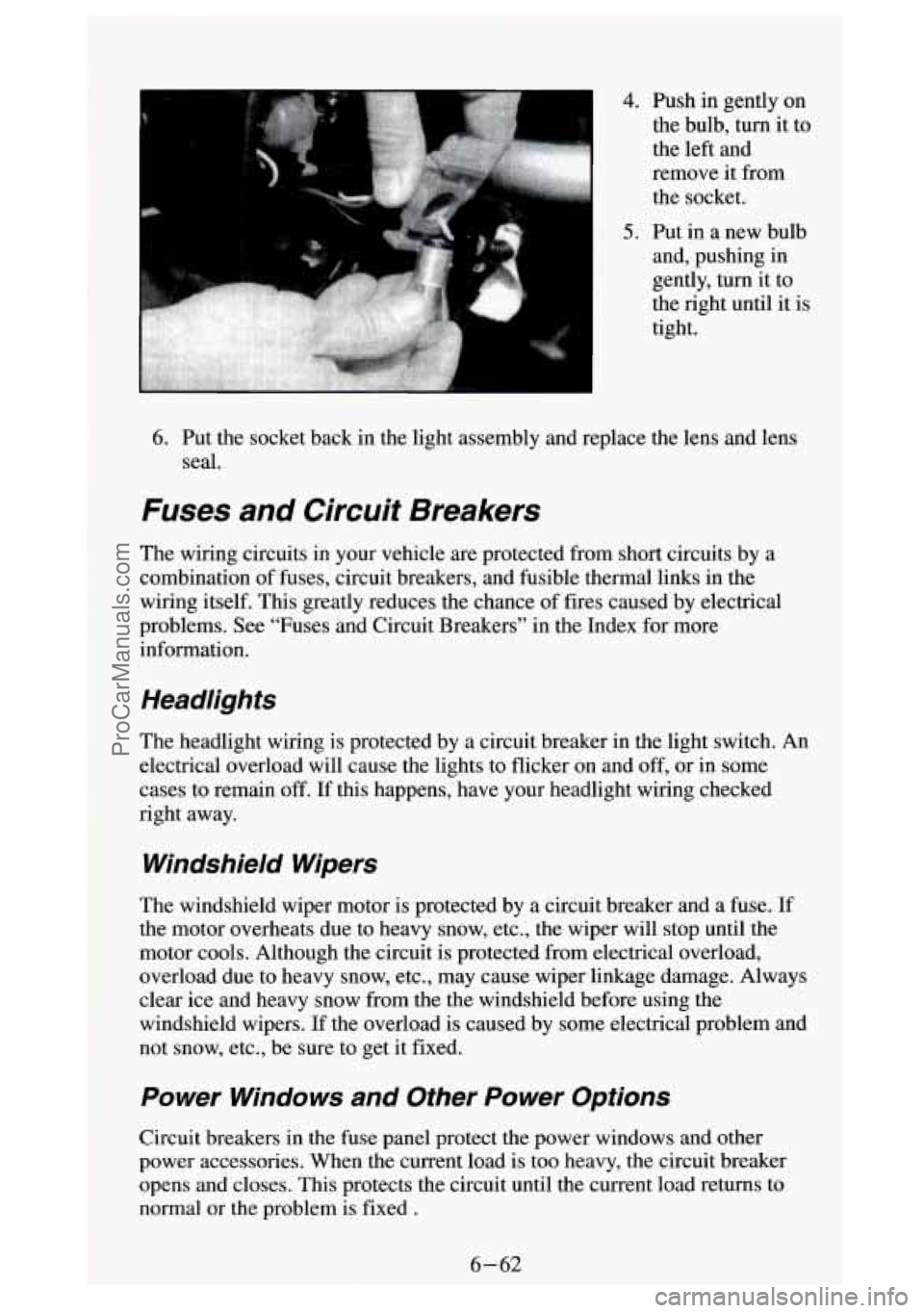
4. Push in gently on
the bulb, turn it to
the left and
remove it from
the socket.
5. Put in a new bulb and, pushing in
gently, turn it to
the right until it is
tight.
6. Put the socket back in the light assembly and replace the lens and lens
seal.
Fuses and Circuit Breakers
The wiring circuits in your vehicle are protected from short circuits by a
combination of fuses, circuit breakers, and fusible thermal links in the
wiring itself. This greatly reduces the chance of fires caused by electrical
problems. See “Fuses and Circuit Breakers” in the Index for more
information.
Headlights
The headlight wiring is protected by a circuit breaker in the \
light switch. An
electrical overload will cause the lights to flicker on and of\
f, or in some
cases to remain
off. If this happens, have your headlight wiring checked
right away.
Windshield Wipers
The windshield wiper motor is protected by a circuit breaker and a\
fuse. If
the motor overheats due to heavy snow, etc., the wiper will stop until the
motor cools. Although the circuit is protected from electrical \
overload,
overload due to heavy snow, etc., may cause .wiper linkage damage. Always
clear ice and heavy snow from the the windshield before using \
the
windshield wipers.
If the overload is caused by some electrical problem and
not snow, etc., be sure to get it fixed.
Power Windows and Other Power Options
Circuit breakers in the fuse panel protect the power windows and other
power accessories. When the current load is too heavy, the circuit breaker
opens and closes. This protects the circuit until the current \
load returns to
normal or the problem is fixed
.
6-62
ProCarManuals.com
Page 313 of 404
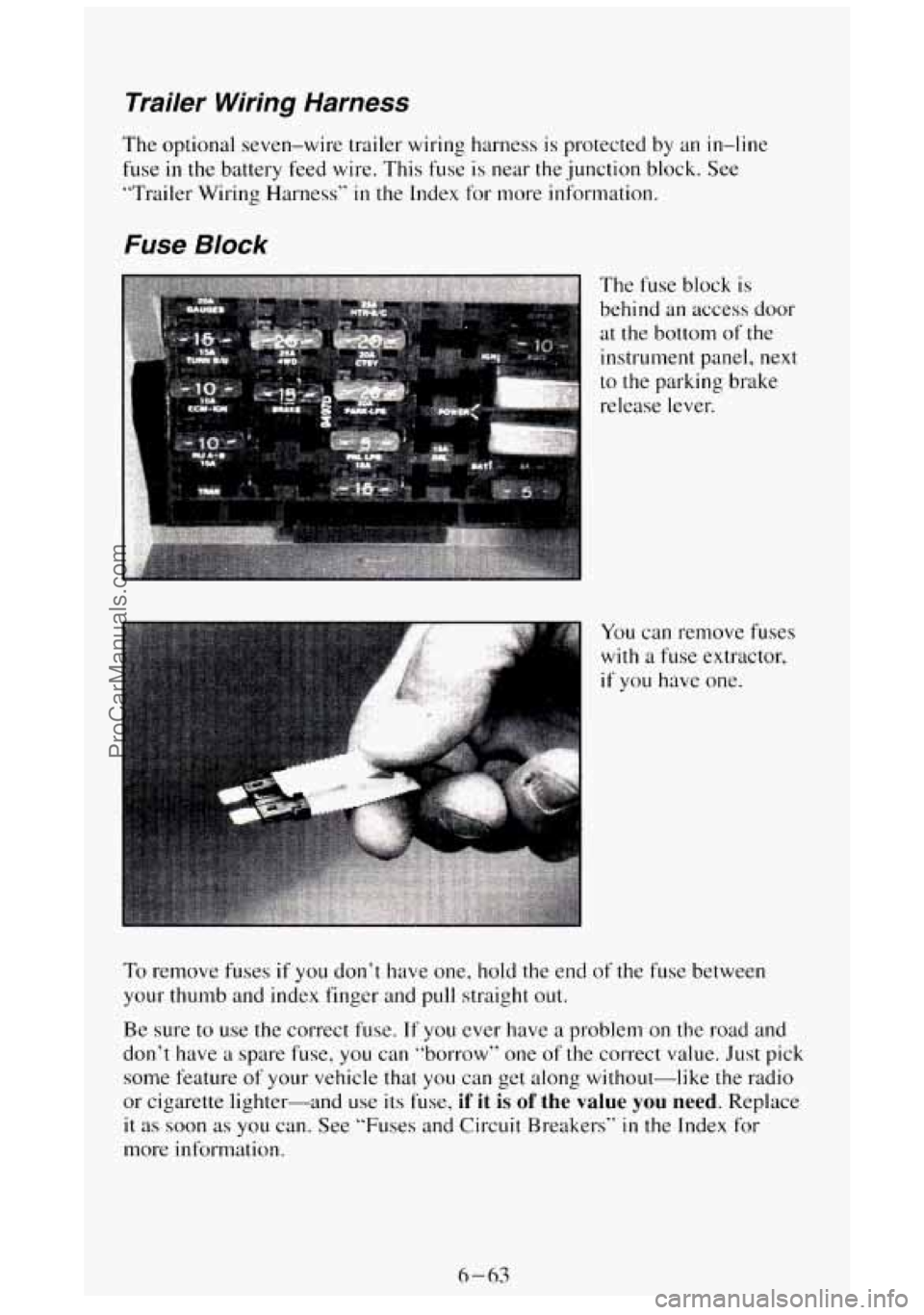
Trailer Wiring Harness
The optional seven-wire trailer wiring harness is protected by an in-line
fuse
in the battery feed wire. This fuse is near the junction block. See
“Trailer Wiring Harness”
in the Index for more information.
Fuse Block
The fuse block is
behind an access door
at the bottom of the
instrument panel,
next
to the parking brake
release lever.
To remove fuses if you don’t have one, hold the end of the fuse between
your thumb and index finger and pull straight out.
Be, sure to use the correct fuse.
If you ever have a problem on the road and
don’t have a spare fuse, you can “borrow” one of the correct value. Just pick
some feature
of your vehicle that you can get along without-like the radio
or cigarette lighter--and use
its fuse, if it is of the value you need. Replace
it as soon as you can. See “Fuses and Circuit Breakers“ in the Index for
more information.
6-63
ProCarManuals.com
Page 314 of 404
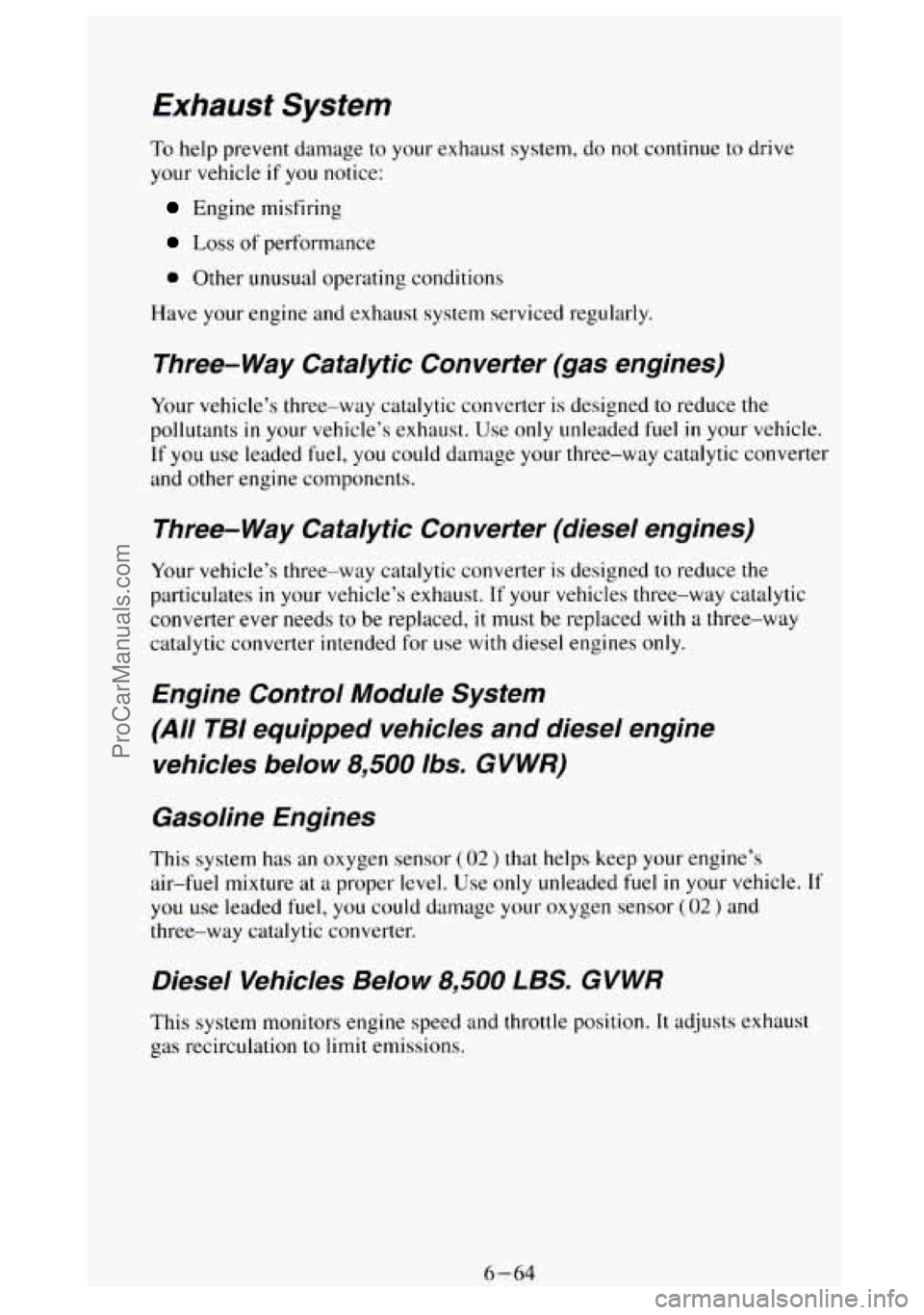
Exhaust System
To help prevent damage to your exhaust system, do not continue to drive
your vehicle
if you notice:
Engine misfiring
Loss of performance
0 Other unusual operating conditions
Have your engine and exhaust system serviced regularly.
Three- Way Catalytic Converter (gas engines)
Your vehicle’s three-way catalytic converter is designed to reduce the
pollutants
in your vehicle’s exhaust. Use only unleaded fuel in your vehicle.
If you use leaded fuel, you could damage your three-way catalytic converter
and other engine components.
Three- Way Catalytic Converter (diesel engines)
Your vehicle’s thre.e-way catalytic converter is designed to reduce the
particulates
in your vehicle’s exhaust. If your vehicles three-way catalytic
converter ever needs to be replaced,
it must be replaced with a three-way
catalytic converter intended for use with diesel engines
only.
Engine Control Module System
(All TBI equipped vehicles and diesel engine
vehicles below
8,500 Ibs. GVWR)
Gasoline Engines
This system has an oxygen sensor (02 ) that helps keep your engine’s
air-fuel mixture at
a proper level. Use only unleaded fuel in your vehicle. If
you use leaded fuel, you could damage your oxygen sensor (02) and
three-way catalytic converter.
Diesel Vehicles Below 8,500 LBS. GVWR
This system monitors engine speed and throttle position. It adjusts exhaust
gas recirculation to limit emissions.
6-64
ProCarManuals.com
Page 315 of 404
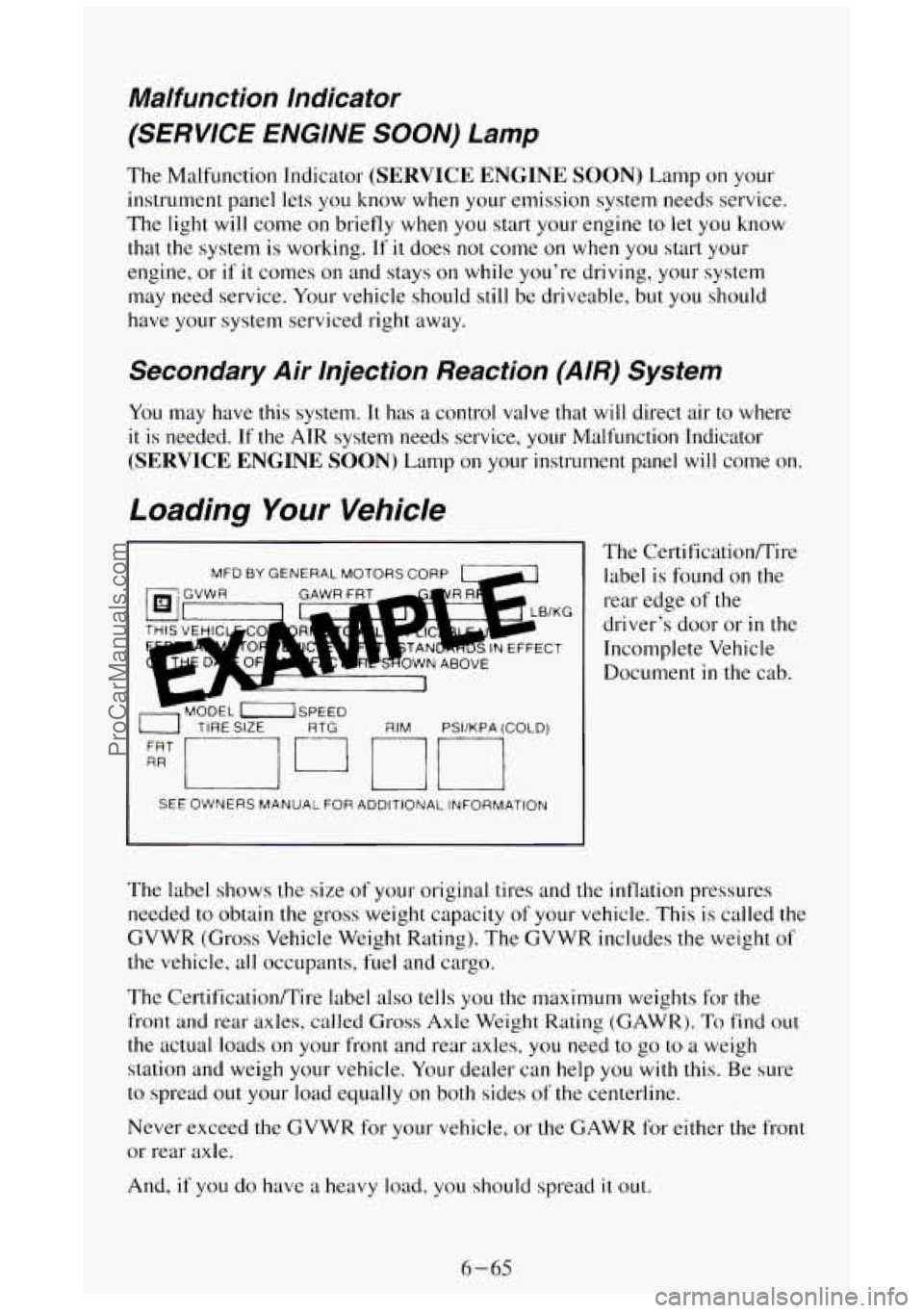
Malfunction Indicator
(SERVICE ENGINE SOON) Lamp
The Malfunction Indicator (SERVICE ENGINE SOON) Lamp on your
instrument panel lets you know when
your emission system needs service.
The light
will come on briefly when you start your engine to let you know
that the system is working. If
it does not come on when you start your
engine,
or if it comes on and stays on while you’re driving, your system
may need service. Your vehicle should still be driveable, but
you should
have your system serviced right away.
Secondary Air hjection Reaction (AIR) System
You may have this system. It has a control valve that will direct air to where
it is needed. If the AIR system needs service, your Malfunction Indicator
(SERVICE ENGINE SOON) Lamp on your instrument panel will come on.
Loading Your Vehicle
SEE OWNERS MANUAL FOR ADDITIONAL INFORMATION
BlKG
The Certification/Tire
label is found on the
rear edge of the
driver’s door or
in the
Incomplete Vehicle
Document
in the cab.
The label shows
the size of your original tires and the inflation pressures
needed to obtain the gross weight capacity of your vehicle. This is called the
GVWR (Gross Vehicle Weight Rating). The GVWR includes the weight of
the vehicle, all occupants, fuel and cargo.
The Certification/Tire label also tells
you the maximum weights for the
front and rear axles, called Gross Axle Weight Rating (GAWR). To find out
the actual loads on your front and rear axles, you need to go to a weigh
station and weigh your vehicle. Your dealer can help you
with this. Be sure
to spread out your load equally
on both sides of the centerline.
Never exceed the GVWR for your vehicle, or
the GAWR for either the front
or rear axle.
And,
if you do have a heavy load, you should spread it out.
6-65
ProCarManuals.com
Page 316 of 404
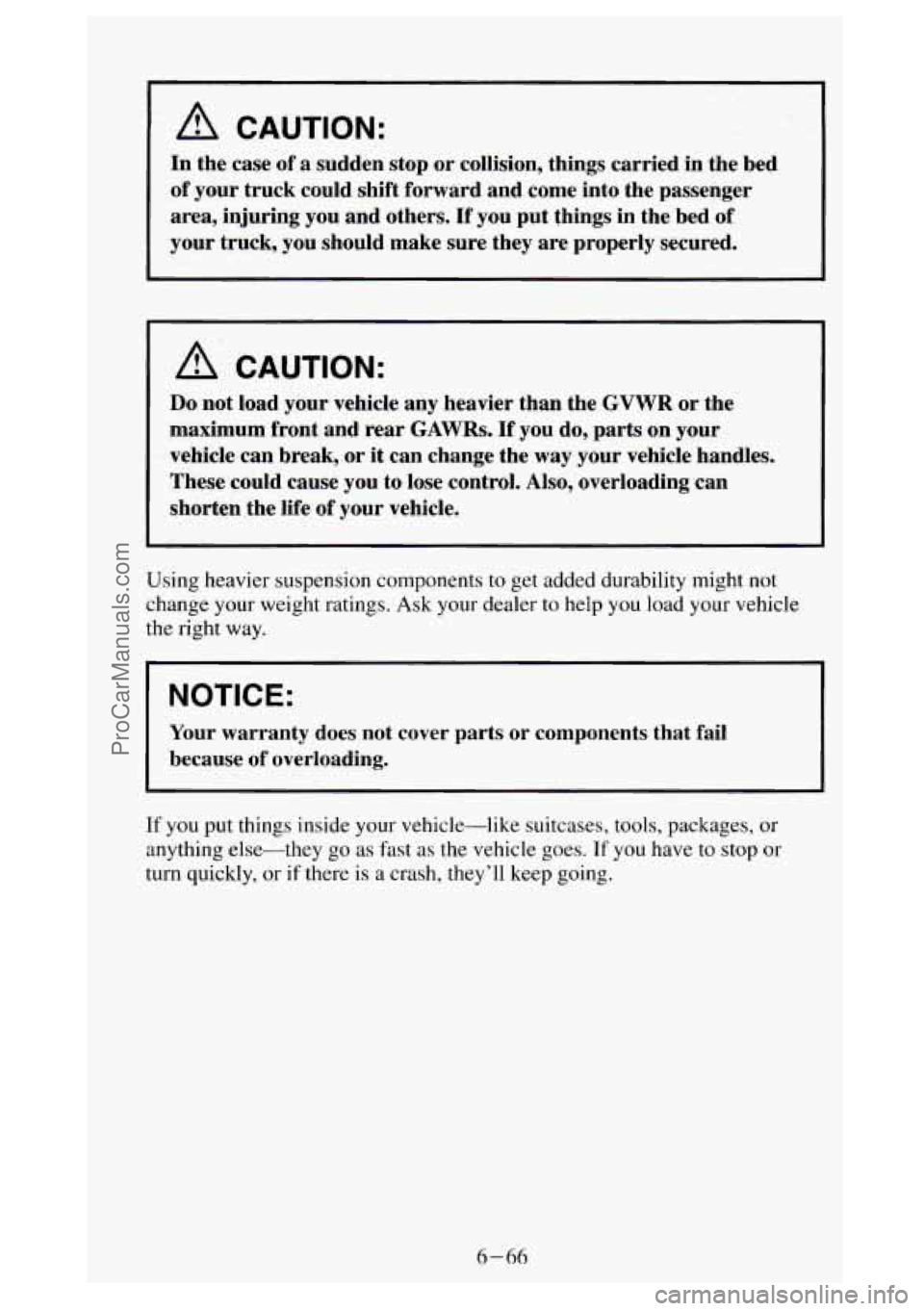
A CAUTION:
In the case of a sudden stop or collision, things carried in the bed
of your truck could shift forward and come into the passenger
area, injuring you and others.
If you put things in the bed of
your truck, you should make sure they are properly secured.
A CAUTION:
Do not load your vehicle any heavier than the GVWR or the
maximum front and rear
GAWRs. If you do, parts on your
vehicle-can break, or it can change the way your vehicle handles.
These could cause you to lose control. Also, overloading can
shorten the Iife
of your vehicle.
Using heavier suspension components to get added durability might not
change your weight ratings.
Ask your dealer to help you load your vehicle
the right
way.
NOTICE:
Your warranty does not cover parts or components that fail
because
of overloading.
If you put things inside your vehicle-like suitcases, tools, packages, or
anything else-they
go as fast as the vehicle goes. If you have to stop or
turn quickly, or if there is a crash, they’ll keep going.
6-66
ProCarManuals.com
Page 317 of 404
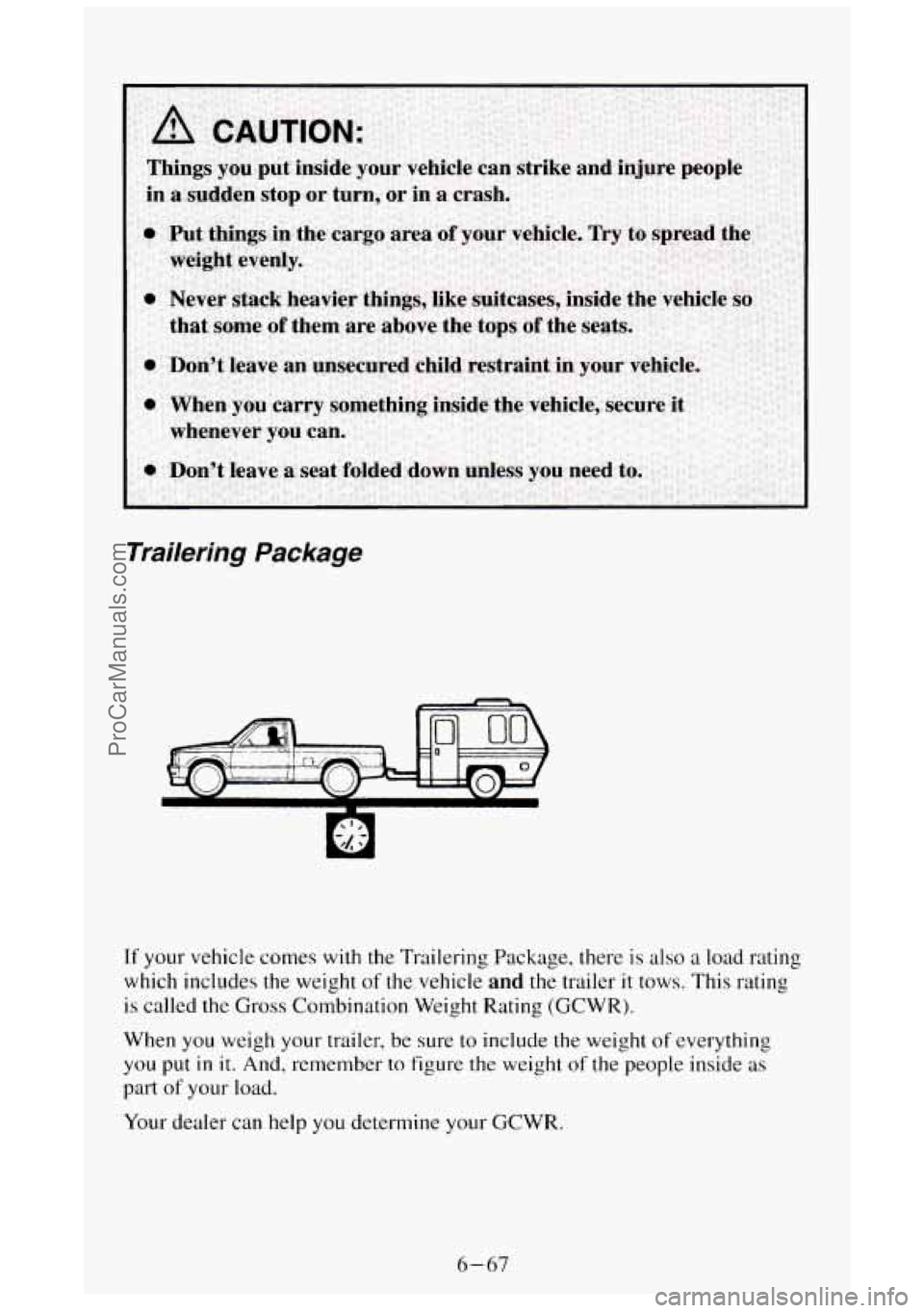
Trailering Package
If your vehicle comes with the Trailering Package, there is also a load rating
which includes the weight
of the vehicle and the trailer it tows. This rating
is called the Gross Combination Weight Rating (GCWR).
When you weigh your trailer, be sure
to include the weight of everything
you put
in it. And, remember to figure the weight of the people inside as
part of your load.
Your dealer can help you determine your GCWR.
6-67
ProCarManuals.com
Page 318 of 404
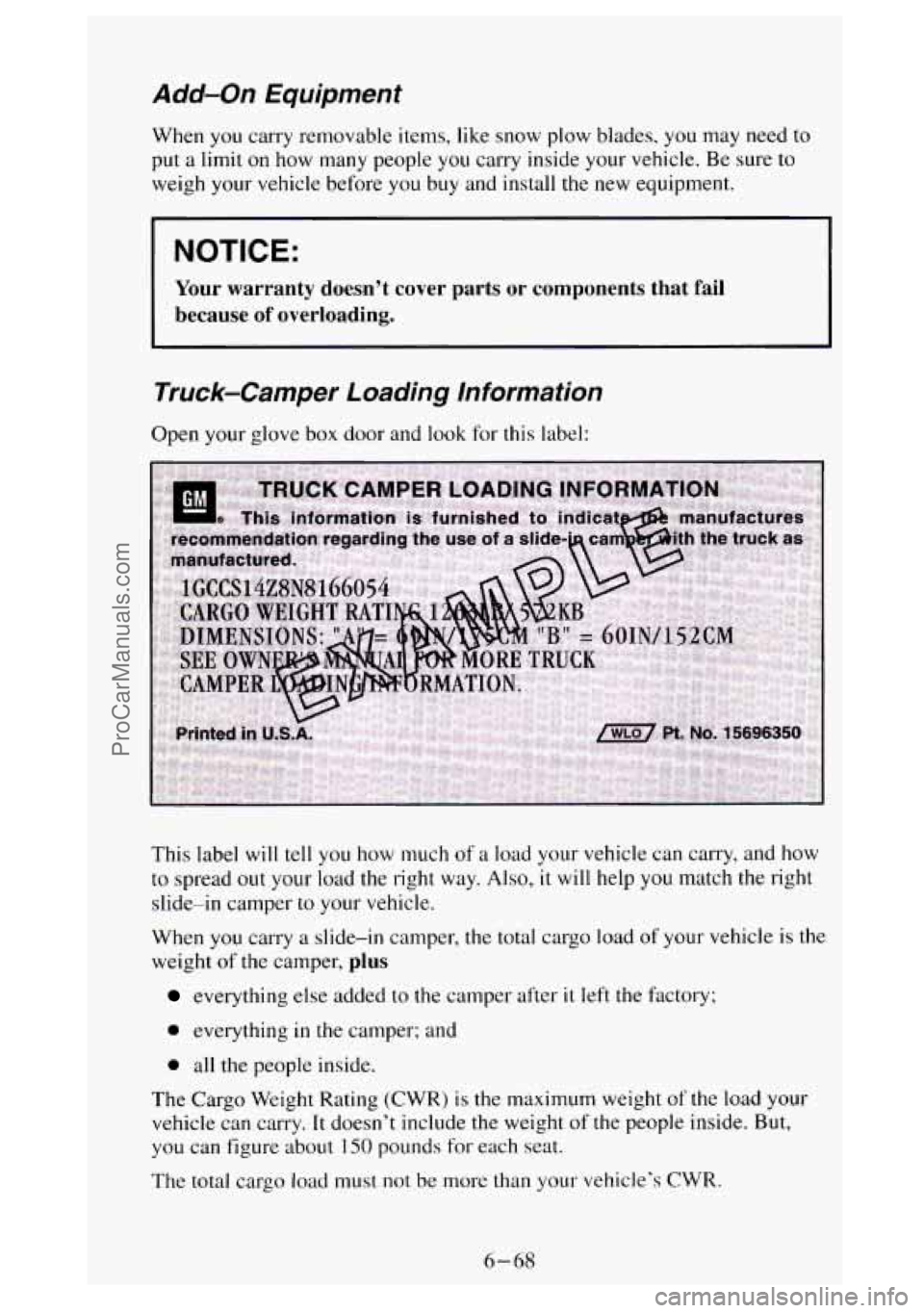
Add-on Equipment
When you carry removable items, like snow plow blades, you may need to
put
a limit on how many people you carry inside your vehicle. Be sure to
weigh your vehicle before you buy and install the new equipment.
i
NOTICE:
Your warranty doesn’t cover parts or components that fail
because
of overloading.
Truck-Camper Loading Information
Open your glove box door and look for this label:
This label will
tell you how much of a load your vehicle can carry, and how
to spread out your load the right way.
Also, it will help you match the right
slide-in camper to your vehicle.
When you carry a slide-in camper,
the total cargo load of your vehicle is the
weight
of the camper, plus
everything else added to the camper after it left the factory;
0 everything in the camper: and
0 all the people inside.
The Cargo Weight Rating (CWR)
is the maximum weight of the load your
vehicle can carry. It doesn’t include the weight
of the people inside. But,
you can figure about
150 pounds for each seat.
The total cargo
load must not be more than your vehicle‘s CWR.
6-68
ProCarManuals.com
Page 319 of 404
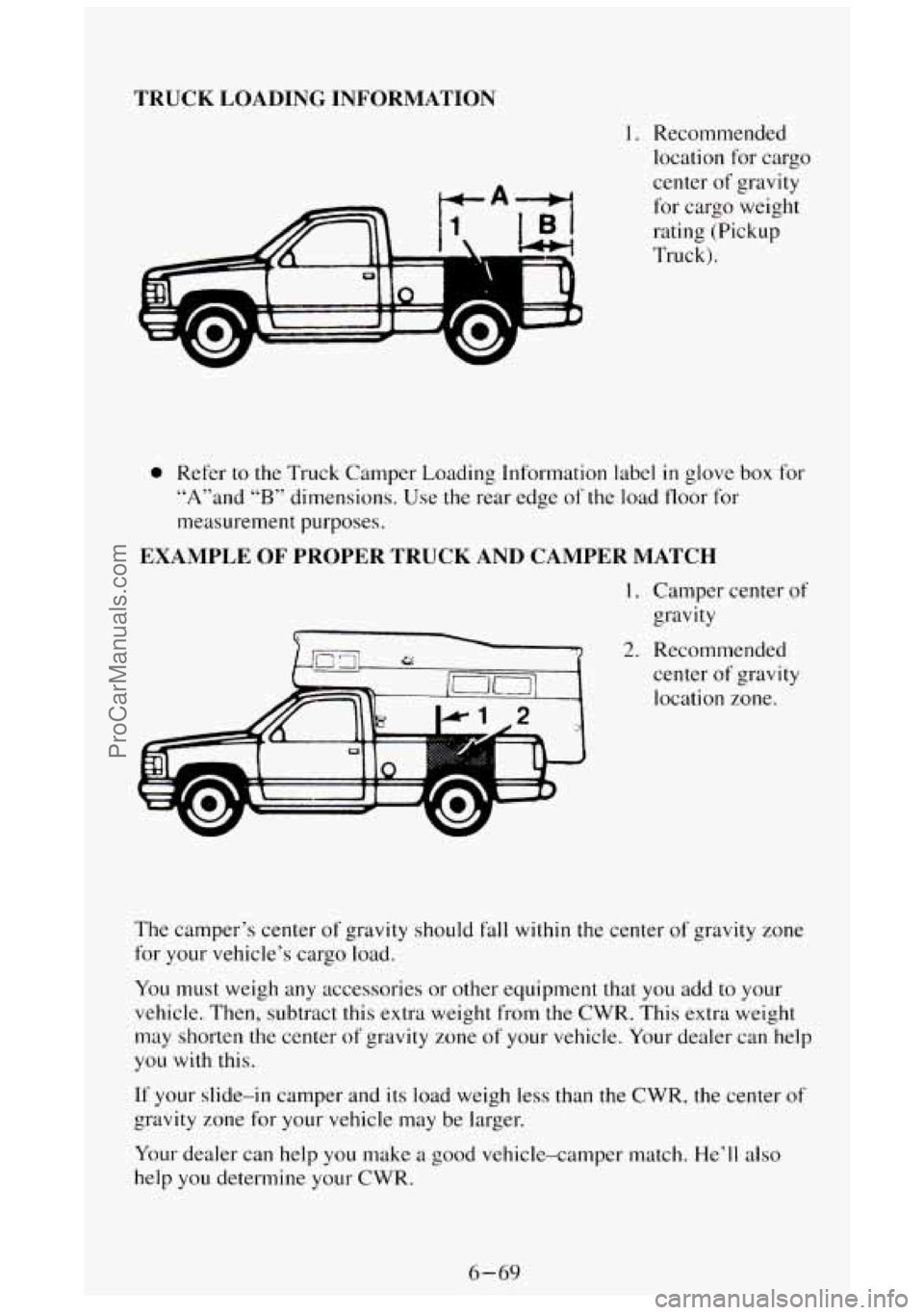
TRUCK LOADING INFORMATION
A
I. Recommended
location for cargo
center of gravity
for cargo weight
rating (Pickup
Truck).
0 Refer to the Truck Camper Loading Information label in glove box for
“A”and
“B” dimensions. Use the rear edge of the load floor for
measurement purposes.
EXAMPLE OF PROPER TRUCK AND CAMPER MATCH
1. Camper center of
gravity
2. Recommended
center
of gravity
location zone.
The camper’s center
of gravity should fall within the center of gravity zone
for your vehicle’s cargo load.
You must weigh any accessories or other equipment that you add to your
vehicle.
Then, subtract this extra weight from the CWR. This extra weight
may shorten the center of gravity zone
of your vehicle. Your dealer can help
you with this.
If your slide-in camper and
its load weigh less than the CWR, the center of
gravity zone for your vehicle may be larger.
Your dealer can help you make
a good vehicle-camper match. He’ll also
help you determine your CWR.
6-69
ProCarManuals.com
Page 320 of 404
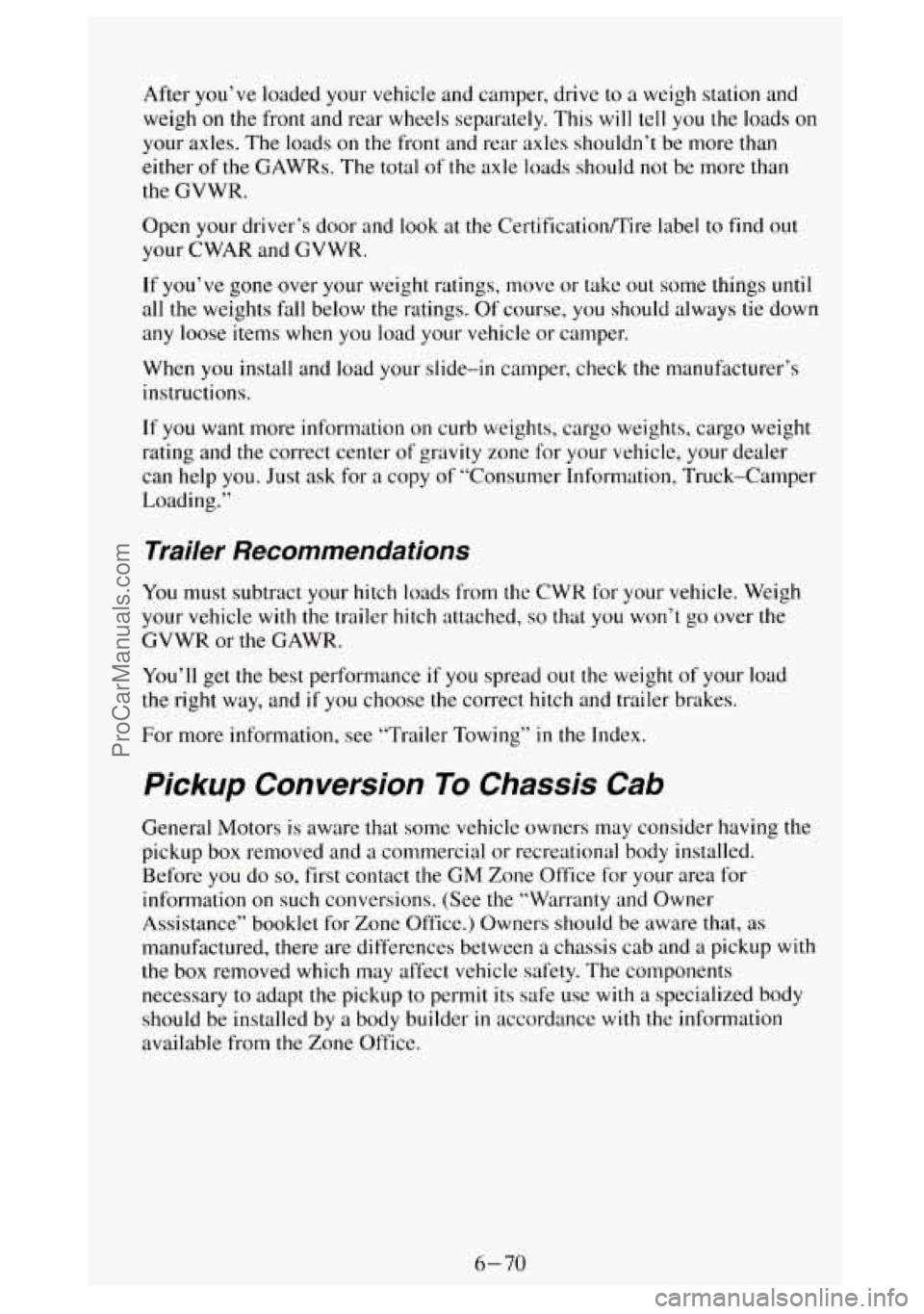
After you’ve loaded your vehicle and camper, drive to a weigh station and
weigh
on the front and rear wheels separately. This will tell you the loads on
your axles. The loads
on the front and rear axles shouldn’t be more than
either of the GAWRs. The total
of the axle loads should not be more than
the GVWR.
Open your driver’s door and look at
the CertificatiodTire label to find out
your CWAR and GVWR.
If
you’ve gone over your weight ratings, move or take out some things until
all the weights fall below the ratings. Of course, you should always tie down
any loose items when you load your vehicle or camper.
When you install and load your slide-in camper, check the manufacturer’s
instructions.
If
you want more information on curb weights, cargo weights, cargo weight
rating and the correct center of gravity zone for your vehicle, your dealer
can help
you. Just ask for a copy of “Consumer Information, Truck-Camper
Loading.”
Trailer Recommendations
You must subtract your hitch loads from the CWR for your vehicle. Weigh
your vehicle with
the trailer hitch attached, so that you won’t go over the
GVWR or the GAWR.
You’ll get the best performance if you spread out the weight of your load
the right way, and if‘ you choose the correct hitch and trailer brakes.
For more information, see “Trailer Towing’’
in the Index.
Pickup Conversion To Chassis Cab
General Motors is aware that some vehicle owners may consider having the
pickup box removed and
a commercial or recreational body installed.
Before
you do so, first contact the GM Zone Office for your area for
information on such conversions. (See the “Warranty and Owner
Assistance” booklet for Zone Office.) Owners should be aware that, as
manufactured, there are differences between a chassis cab and a pickup with
the box removed which may affect vehicle safety. The components
necessary to adapt
the pickup to permit its safe use with a specialized body
should be installed by a body builder
in accordance with the information
available from
the Zone Office.
6-70
ProCarManuals.com